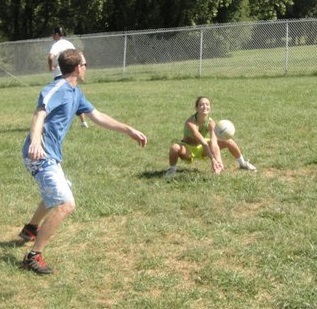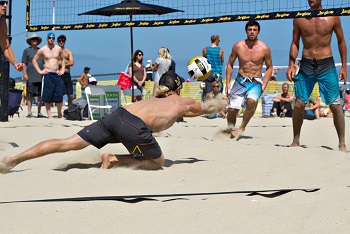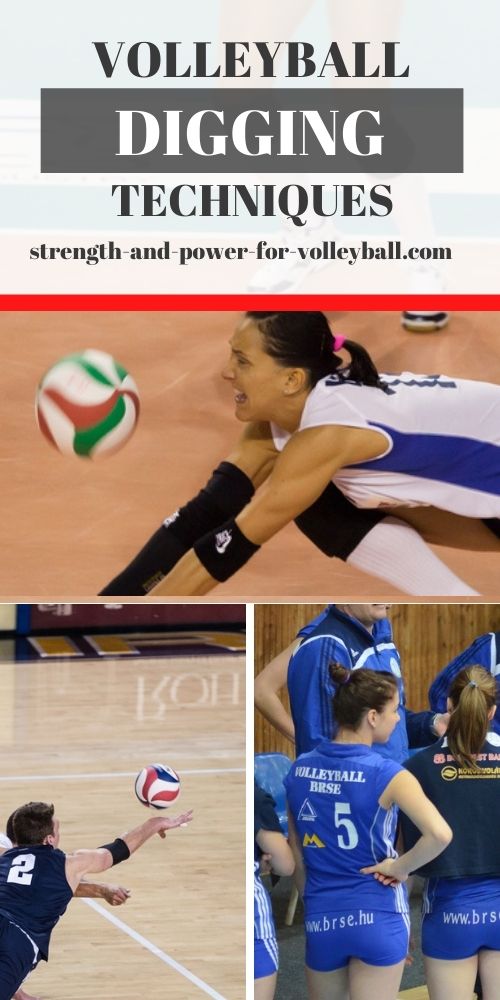Volleyball Digging on the Beach
Defense Techniques and Strategies
Volleyball digging and making great defensive plays on the beach takes discipline and patience.
Defense on the Beach
The skill for playing great defense on the beach is more of a art than a science.
As a defender, you'll face many different kinds of attacks. An attacker could swing hard or hit a soft shot. A great
defender indoors may not necessarily be a great defender in the sand.
Indoors, you have a much smaller area you need to cover.
When playing indoor, you hold your position and play the ball in front of you.
On the beach, the ball could come high forcing you to take the ball with
your hands, or you might have to take a 30-foot dash and dive for the
ball.
Beach Dig
Karch Kiraly
"I know that if you go after every ball on defense,
you're going to get some of those impossible balls up from time to
time....and win some important games because of it."
-- Karch Kiraly
Techniques for Defense
Starting position
Always start in an athletic stance. Stand with feet slightly wider than
shoulder width, well-balanced, and ready to move in any direction.
You want to start with your arms and hands apart, ready to move to the ball first before you dig it.
Digging hard-driven balls
For a hard-driven ball, cushion the impact, keeping the ball on your
side of the net. Pass the ball at least 10 feet high so your partner can
get to it.
Ready to Move and React on Defense
When volleyball digging, you might pull your arms back a little or fall back to help absorb some of the force.
If you can, always use two arms when you dig.
Watch your face!
If a ball comes hard to your face, use the overhand volleyball digging
technique by letting the ball hit your palms and fingers all at once. In
sand volleyball, it's legal to
slightly lift and push a hard-driven ball with your hands. Slightly catch the ball and push it to the target position.
Defensive Mindset
Great defensive players know that playing great defense is all about having the right attitude.
Great defenders believe they can get every ball, no matter where it is.
This requires you to go hard after every ball, hurling your body toward
it
to get it up.
If you can only get one arm on it, use the one that's closest to the
ball. This can be difficult if you have to use your non-dominant arm.

Being Mobile in the Grass
The key to volleyball digging making great defensive plays
The key is to get the ball up. You then must get up and get in position to attack.
For a ball that's really hard to make a play on, don't worry about how
well you pass it. Don't worry about accuracy and just focus on getting
the ball
up to the middle of the court so your partner can set it.
Play the Ball Low on Defense - Volleyball Digging
It's important to play the ball low on defense. Being low gives you more time to make a play on the ball.
This is also true for when volleyball setting or when you have to run down a ball that's deflected off your partner blocking at the net. If you stay low, you will get some
surprising saves that can turn matches around.
Good positioning
Where you start on defense is called positioning. Usually you should
start about 10 or 15 feet back from the net. This position depends on
who you're playing.
For example, if your opponent has the ability to hit the ball down at
sharp angles into the court, then you'll have to adjust your
positioning.
From this position, you must be ready to go in any direction or distance to get to the ball.
Knowing your range
Volleyball digging and playing great defense is all about "knowing your
range". Great defenders know exactly how much of the court they can give
up. Your ability
to anticipate and read the play that's unfolding influences where you
should be positioned on defense.
For example, if you are highly skilled at reading and anticipating, then you can
leave more court open for your opponent. This gives the illusion that there is
more court for your opponent to hit into. As a defender, you can "bait" the
hitter into thinking there is an open spot. Since you "know your range", you can
easily run down the shot which leads to making a great defensive play.
Quickness, reading dinks or shots, knowing what your opponent does well
(what shots they like to hit) are all important factors to making great
defensive
plays.
If you enjoyed these tips and would like to keep it close to you at any time, just save this pin to your Pinterest Volleyball Training Board.

